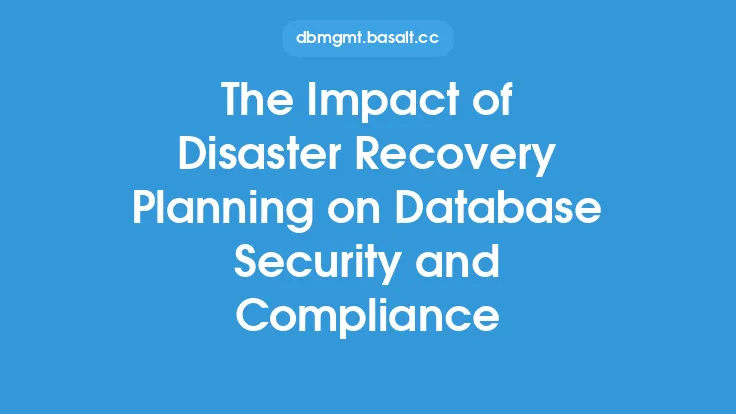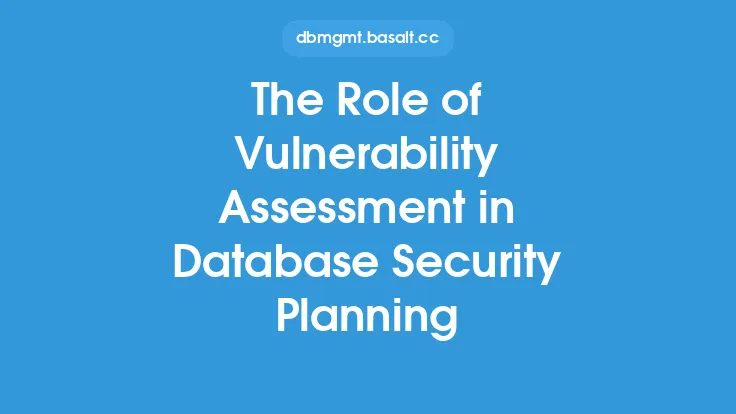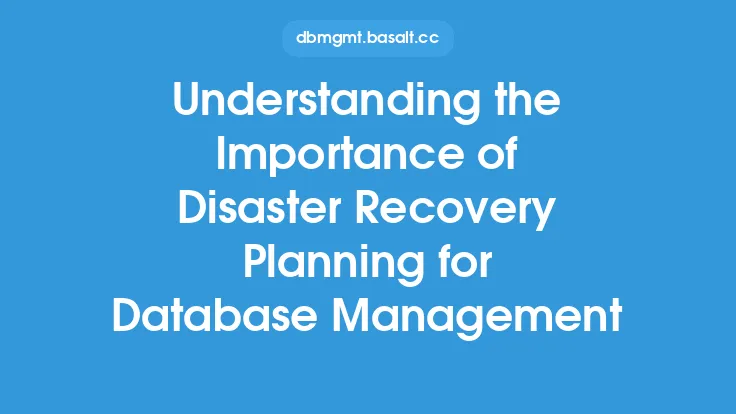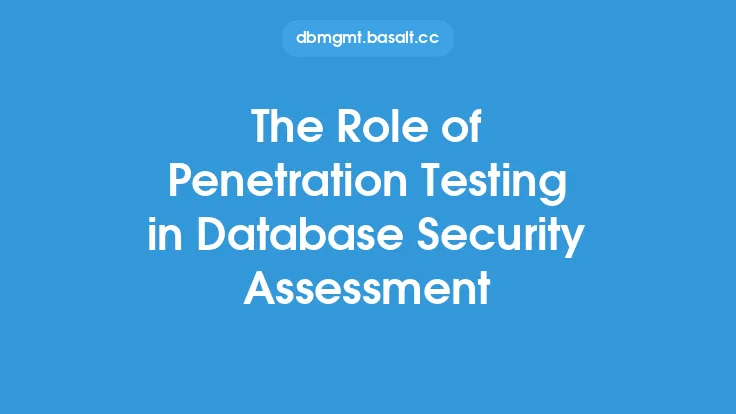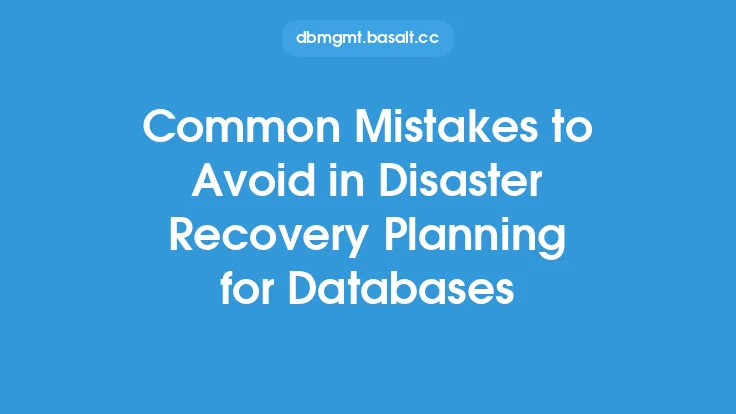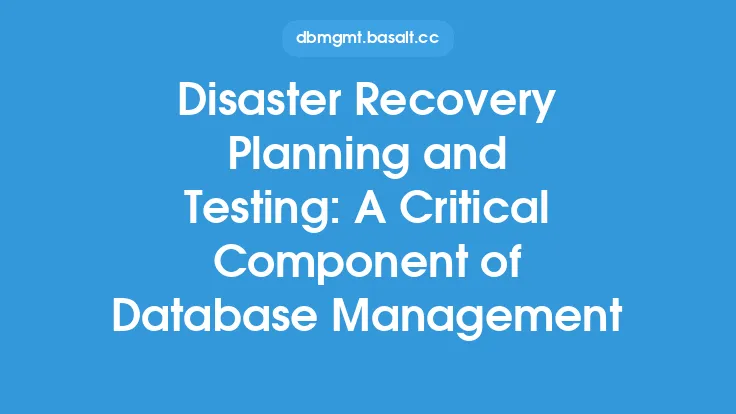Disaster recovery planning is a critical aspect of database management, and risk assessment plays a vital role in this process. Risk assessment is the process of identifying, analyzing, and evaluating potential risks that could impact an organization's ability to recover from a disaster. It is a crucial step in developing a comprehensive disaster recovery plan, as it helps organizations understand the potential risks and threats to their database systems and develop strategies to mitigate them.
Introduction to Risk Assessment
Risk assessment is a systematic process that involves identifying potential risks, analyzing their likelihood and impact, and evaluating their potential effects on an organization's database systems. The goal of risk assessment is to identify potential risks and develop strategies to mitigate or manage them. In the context of disaster recovery planning, risk assessment helps organizations identify potential risks that could impact their ability to recover from a disaster, such as natural disasters, cyber-attacks, or equipment failures.
Types of Risks
There are several types of risks that organizations should consider when developing a disaster recovery plan. These include:
- Natural disasters, such as earthquakes, hurricanes, or floods
- Cyber-attacks, such as hacking or malware
- Equipment failures, such as server or storage failures
- Human errors, such as accidental data deletion or corruption
- Environmental disasters, such as power outages or water damage
Each of these risks has the potential to impact an organization's database systems and disrupt business operations.
Risk Assessment Methodologies
There are several risk assessment methodologies that organizations can use to identify and evaluate potential risks. These include:
- Quantitative risk assessment, which involves assigning numerical values to potential risks and evaluating their likelihood and impact
- Qualitative risk assessment, which involves evaluating potential risks based on their likelihood and impact, but without assigning numerical values
- Hybrid risk assessment, which combines elements of quantitative and qualitative risk assessment
The choice of risk assessment methodology will depend on the organization's specific needs and requirements.
Identifying Potential Risks
Identifying potential risks is a critical step in the risk assessment process. Organizations should consider a range of factors, including:
- The likelihood of a disaster occurring
- The potential impact of a disaster on database systems and business operations
- The effectiveness of existing disaster recovery procedures
- The availability of resources, such as personnel, equipment, and funding
Organizations should also consider the potential risks associated with different types of disasters, such as natural disasters or cyber-attacks.
Analyzing and Evaluating Risks
Once potential risks have been identified, organizations should analyze and evaluate them to determine their likelihood and potential impact. This involves considering a range of factors, including:
- The probability of a disaster occurring
- The potential consequences of a disaster, such as data loss or system downtime
- The effectiveness of existing controls and mitigation strategies
- The availability of resources, such as personnel, equipment, and funding
Organizations should also consider the potential risks associated with different types of disasters, such as natural disasters or cyber-attacks.
Developing a Risk Assessment Report
The final step in the risk assessment process is to develop a risk assessment report. This report should summarize the potential risks that have been identified, analyzed, and evaluated, and provide recommendations for mitigating or managing them. The report should also include an assessment of the organization's overall risk posture and provide recommendations for improving it.
Implementing Risk Mitigation Strategies
Once a risk assessment report has been developed, organizations should implement risk mitigation strategies to address the potential risks that have been identified. These strategies may include:
- Developing and implementing disaster recovery procedures
- Implementing backup and recovery systems
- Conducting regular system maintenance and testing
- Providing training and awareness programs for personnel
- Implementing security controls, such as firewalls and intrusion detection systems
The goal of risk mitigation strategies is to reduce the likelihood and potential impact of disasters, and to ensure that organizations can recover quickly and effectively in the event of a disaster.
Monitoring and Reviewing Risk Assessment
Risk assessment is an ongoing process that requires continuous monitoring and review. Organizations should regularly review and update their risk assessment reports to ensure that they remain relevant and effective. This involves:
- Monitoring potential risks and threats
- Reviewing and updating risk assessment reports
- Implementing new risk mitigation strategies
- Conducting regular system maintenance and testing
- Providing training and awareness programs for personnel
The goal of monitoring and reviewing risk assessment is to ensure that organizations remain aware of potential risks and threats, and can respond quickly and effectively in the event of a disaster.
Conclusion
Risk assessment is a critical component of disaster recovery planning, and plays a vital role in helping organizations understand the potential risks and threats to their database systems. By identifying, analyzing, and evaluating potential risks, organizations can develop effective risk mitigation strategies and ensure that they can recover quickly and effectively in the event of a disaster. Regular monitoring and review of risk assessment reports is also essential to ensure that organizations remain aware of potential risks and threats, and can respond quickly and effectively in the event of a disaster.
